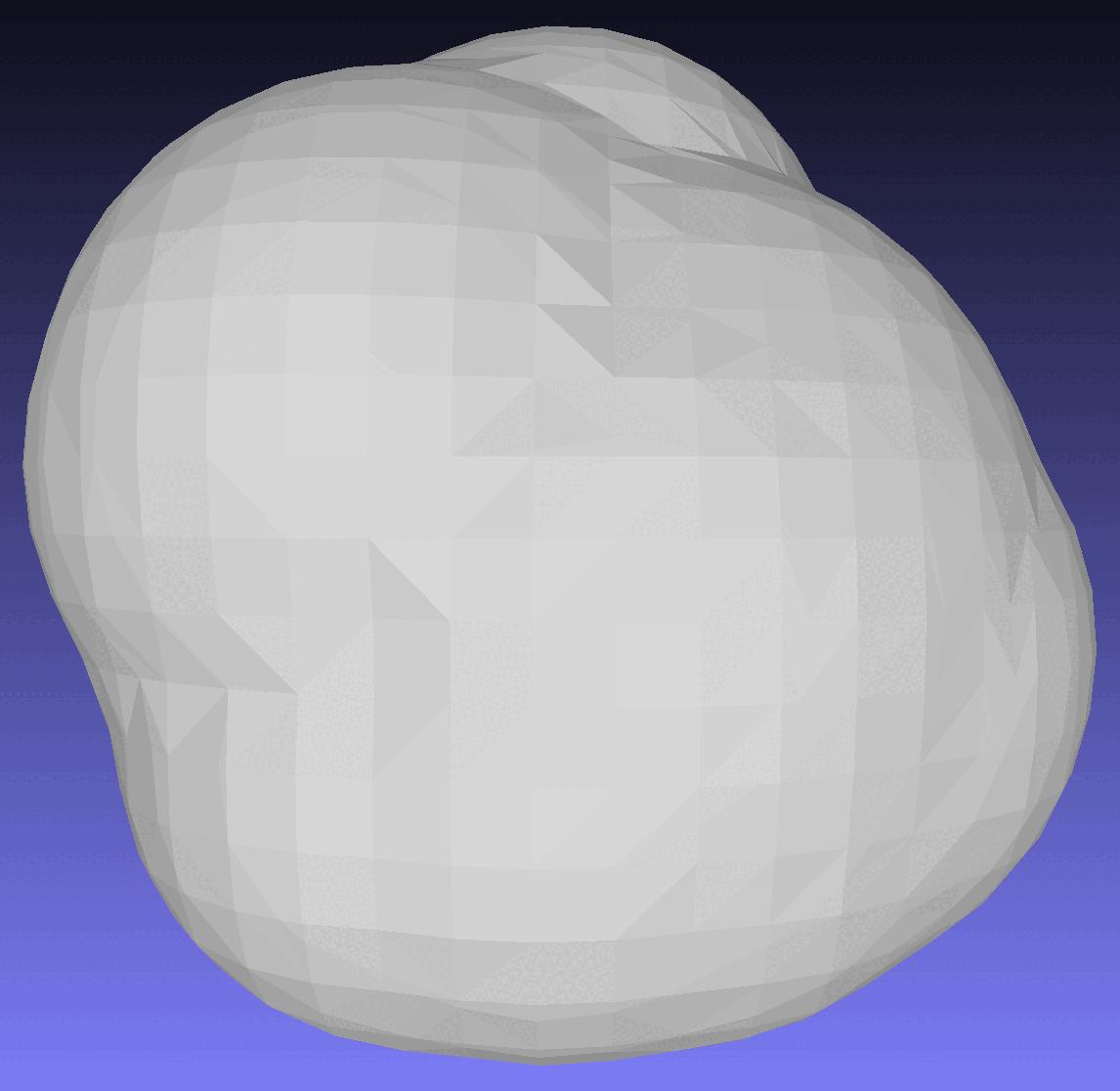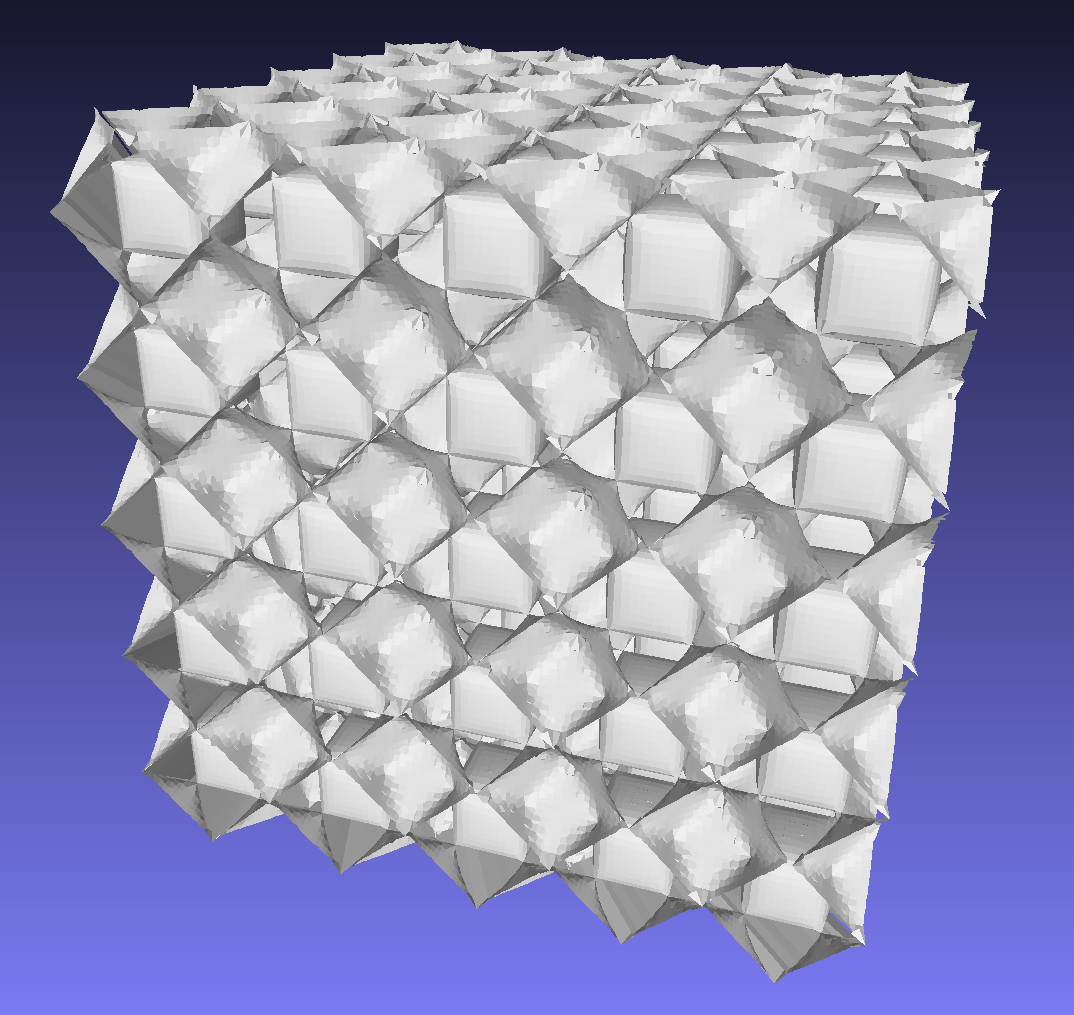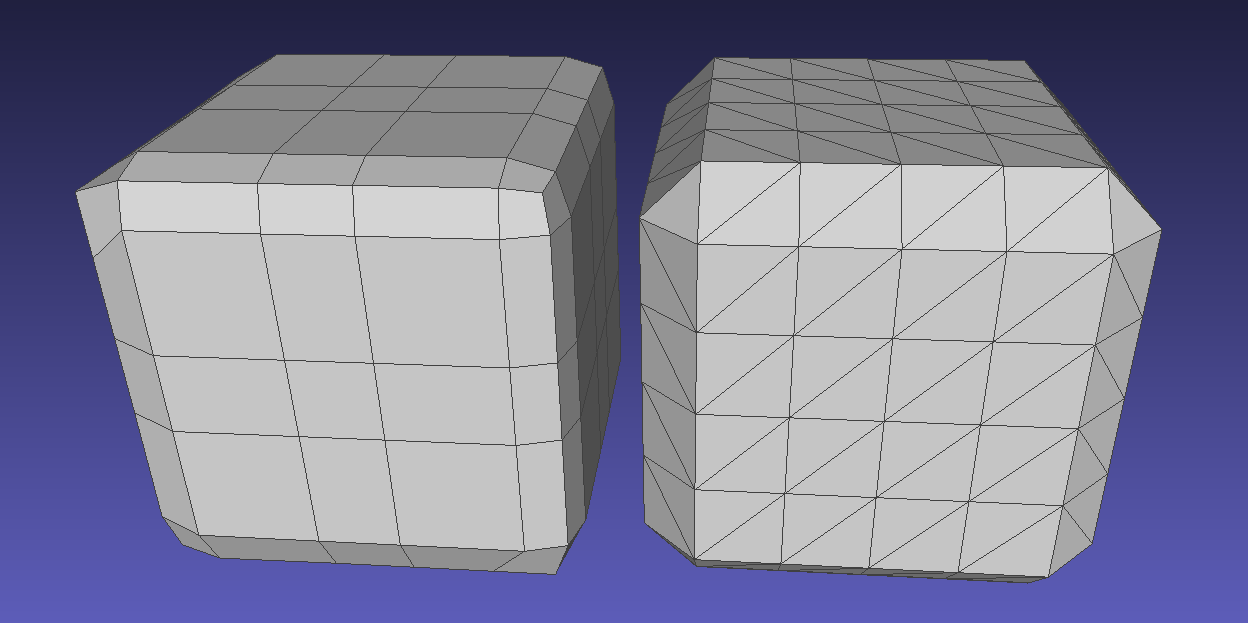|
CGAL 5.6 - 3D Isosurfacing
|
|
CGAL 5.6 - 3D Isosurfacing
|

This package provides methods to compute a surface mesh representing an isosurface of a 3-dimensional scalar field. An isosurface is defined as the surface on which the value of this field is equal to a given constant, i.e. the isovalue. Depending on the isosurfacing method and the input data structure, the result is either a triangular, quadrilateral, or higher order polygonal indexed face set.
There are multiple algorithms to extract isosurfaces. This package contains Marching Cubes, topologically correct Marching Cubes, and Dual Contouring.
MC processes all cells of the input domain individually. Each cell corner gets a sign (+/-) to indicate if it is above or below the isovalue. A new vertex is created on every cell edge where the sign changes, i.e. the isosurface is intersected. The vertex position is computed via linear interpolation of the scalar values of the incident corners. Depending on the configuration of signs at the corners the resulting vertices are connected to form triangles within the cell.
MC can process any input data structure that consists of hexahedral cells. In case of a conforming grid, MC produces a triangle mesh that is manifold in most scenarios. If the mesh is manifold and the isosurface does not intersect the domain boundaries, the mesh is also watertight. Compared to other approaches the algorithm often generates more and many thin triangles with acute angles. MC does not preserve sharp features of the input data.

This algorithm is an extension to MC and provides additional guarantees for the output. It generates a mesh that is homeomorphic to the trilinear interpolant of the input function inside each cube. This means that the mesh can accurately represent small complex features. For example a tunnel of the isosurface within a single cell can be topologically resolved. Furthermore, the mesh is guaranteed to be manifold and watertight, as long as the isosurface does not intersect the domain boundaries.
This algorithm is based on the following paper:
Roberto Grosso: Construction of Topologically Correct and Manifold Isosurfaces. Computer Graphics Forum 35(5):187-196 - August 2016
DC creates one vertex in every cell that is intersected by the isosurface. Next, a face is created for each edge that intersects the isosurface, by connecting the vertices of the incident cells. For a uniform hexahedral grid, this results in a quadrilateral mesh.
The classical DC method requires the gradient of the scalar field. The provided domain therefore has to implement the concept IsosurfacingDomainWithGradient. All default domain implementations do this but assume the gradient to be zero if it is not provided as an additional parameter. Thus, for using the classical DC, the gradient has to be defined by the user. Alternatively, there are also some default gradient functions implemented, such as Finite_difference_gradient and Explicit_cartesian_grid_gradient.
Different versions of DC compute the vertex positions differently. Therefore, the vertex positioning is configurable with an optional parameter passed to the function. Some of them do not require the gradient and therefore even work with the zero gradient.
Dual Contouring works on any domain but does not guarantee a manifold or watertight mesh. It creates less faces than Marching Cubes. Another advantage of DC over MC is the ability to represent sharp edges.

| Algorithm | Domains | Faces | Manifold | Watertight* | Topologically correct |
|---|---|---|---|---|---|
| MC | Hexahedral | Triangles | no | no | no |
| TMC | Hexahedral | Triangles | yes | yes | yes |
| DC | All | Polygons | no | no | no |
(* assuming the isosurface does not leave the given bounding box of the domain)

Each algorithm is represented by a single functions. The function signature is the same for all algorithms:
The input is provided in the form of a domain (see Domains).
The iso_value parameter describes the grid value the isosurface should represent.
The output is in the form of an indexed face set that is written to the two collections points and polygons. The vertex positions are stored as Point_3 in points. Each face in polygons is a list of indices pointing into the points collection. Depending on the algorithm, the indexed face set may either store a polygon soup or a topological mesh.
Algorithms can run sequentially on one CPU core or in parallel. The Concurrency_tag is used to specify how the algorithm is executed and is either Sequential_tag or Parallel_tag. To enable parallelism, CGAL needs to be linked with the Intel TBB library. If the parallel version is not availible the sequential version will always be used as a fallback.
A domain is an object that provides functions to access the input data, its geometry, topology, and optionally its gradient. There are some predefined domain classes that wrap the input data and provide a generalized interface for the algorithm. Users can also define new domains by implementing the Isosurfacing_domain or IsosurfacingDomainWithGradient concept.
The Implicit_cartesian_grid_domain represents the input function in an implicit form without storing any values. It takes a functor or lambda that computes the value of the function from the position of a vertex as parameter. Additionally, the bounding box and spacing between grid points have to be specified.
The Explicit_cartesian_grid_domain only takes a Cartesian_grid_3 as parameter. It represents a uniform grid of values that are either computed by the user or read from an Image_3. The constructor of Cartesian_grid_3 needs the number of grid points in each dimension and the bounding box. The values are read and written with value(x, y, z) where x, y, and z are the coordinates of a grid point. Alternatively, all required data can be copied from an Image_3.
The following example shows the usage of the Marching Cubes algorithm to extract an isosurface. The domain is an Implicit_domain that describes a sphere by the distance to its origin as an implicit function.
File Isosurfacing_3/marching_cubes_implicit_sphere.cpp
The following example compares all provided algorithms to extract an isosurface. The domain is an Cartesian_grid_domain that describes a cube by storing the manhattan distance to its origin in a Cartesian_grid_3.
File Isosurfacing_3/all_cartesian_cube.cpp
The following example shows how to load data from an Image_3.
File Isosurfacing_3/marching_cubes_inrimage.cpp
The following example shows how to compute an offset mesh. The original mesh is passed to an AABB_tree to allow fast distance queries. With the use of Side_of_triangle_mesh the sign of the distance function is flipped inside the mesh.
File Isosurfacing_3/dual_contouring_mesh_offset.cpp